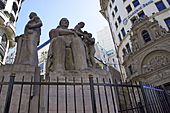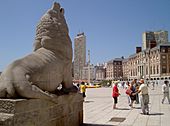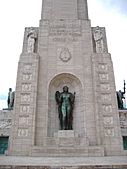José Fioravanti facts for kids
Quick facts for kids
José Fioravanti
|
|
|---|---|
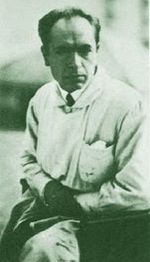 |
|
| Born | August 4, 1896 |
| Died | October 10, 1977 (aged 81) Buenos Aires
|
| Nationality | Argentine |
José Fioravanti (born August 4, 1896 – died October 10, 1977) was a famous sculptor from Argentina. He created many important public statues and monuments.
Contents
Life and Work of a Sculptor
José Fioravanti was born in Buenos Aires in 1896. From a young age, he was very interested in sculpture. He learned this art in private workshops, called ateliers, around the city.
Early Art and First Awards
Fioravanti taught himself much of what he knew. He first showed his art in 1912 at the National Art Show. In 1919, he won the First Prize at the National Art Show for his work called My Sister María.
Traveling and New Techniques
For several years, Fioravanti mainly created realistic portraits of people's heads and shoulders. These were made by a method called casting, where liquid material is poured into a mold. One famous example is the portrait of former President José Figueroa Alcorta.
From 1924 to 1927, Fioravanti traveled in Europe. There, he learned a new way of working called direct carving. This meant he carved directly into the material without first making small models, called maquettes. He showed his art in big museums like the Museum of Modern Art, Madrid and the Luxembourg Museum in Paris.
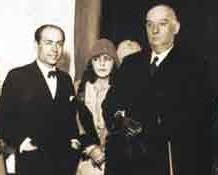
Exhibitions and Important Commissions
After returning to Argentina, Fioravanti had two solo art shows in Buenos Aires. One show in 1928 was opened by President Marcelo Torcuato de Alvear. The President was so impressed that he asked Fioravanti to create decorative reliefs for the inside of the Casa Rosada. Reliefs are sculptures that stick out from a flat surface.
In 1929, Fioravanti went back to Paris. He became even more famous there. In 1934, he had another special solo exhibition at the Galerie nationale du Jeu de Paume.
Teaching and Famous Monuments
Fioravanti returned to Argentina in 1935. He became a Professor at the College of Fine Arts. In 1936, his portrait of his wife, Ludmilla Feodorovna, called Woman with Book, won a gold medal at the National Art Show.
He set up his workshop in La Lucila del Mar, a town by the sea. Over the years, he created many famous monuments, including:
- Memorials in Buenos Aires for Presidents Nicolás Avellaneda and Roque Sáenz Peña (1935–1936).
- A statue of Venezuelan General Simón Bolívar in Buenos Aires (1942).
- A monument for U.S. President Franklin Roosevelt.
- Two large sea lion statues in Mar del Plata (1941).
- A memorial in Montevideo, Uruguay, for General Fructuoso Rivera (1965).
- A statue for General Manuel Savio, known as the father of Argentina's steel industry, in Villa María, Córdoba (1969).
The National Flag Memorial
Another very important project for Fioravanti was the National Flag Memorial. This large monument is in the city of Rosario, overlooking the Paraná River. It was built between 1947 and 1957.
For this memorial, Fioravanti created a monument to Manuel Belgrano, who created the Argentine flag. He also made five allegorical sculptures. These sculptures represent ideas or qualities, not real people. They were made from bronze and a type of stone called travertine.
Fioravanti worked with another sculptor, Alfredo Bigatti, on this project. They had also worked together on the Roosevelt memorial, where Bigatti created sculptures representing the Four Freedoms.
José Fioravanti passed away in 1977 in Buenos Aires.
Images for kids
-
Sea Lion (Mar del Plata, 1941)
-
The Motherland (National Flag Memorial, Rosario, 1957)
See also
 In Spanish: José Fioravanti para niños
In Spanish: José Fioravanti para niños


